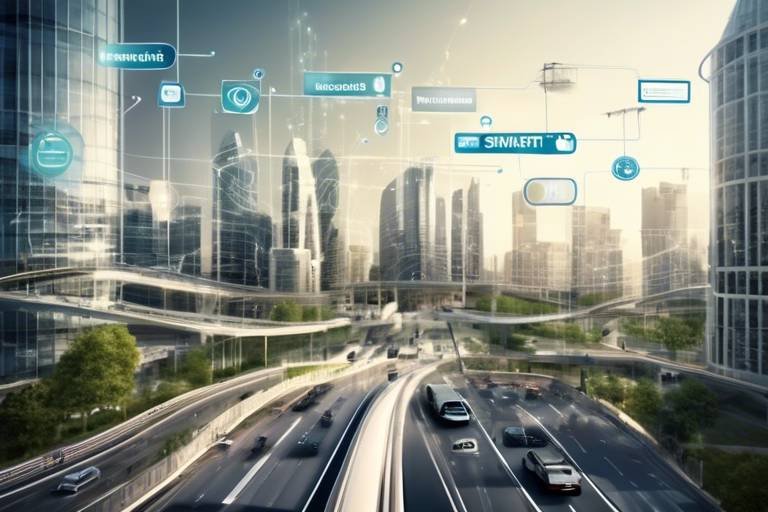How Robotics is Changing Waste Management Practices
In a world increasingly focused on sustainability and efficiency, robotics is stepping up to the plate, transforming the way we manage waste. Imagine a future where robots are not just a part of science fiction but are actively engaged in making our cities cleaner and greener. As we delve into the innovative technologies reshaping waste management, we’ll uncover how these advancements are not only enhancing operational efficiency but also contributing to a healthier planet. The integration of robotics into waste management practices is like adding a turbocharger to an already efficient engine—it amplifies performance and drives us toward a more sustainable future.
As urban populations continue to swell, the challenge of waste management becomes more pronounced. Traditional methods are increasingly strained under the weight of growing waste volumes, and labor shortages are making it difficult to keep up with demand. This is where robotics comes in, offering solutions that are both effective and innovative. By leveraging technologies such as artificial intelligence and machine learning, waste management can be revolutionized, ensuring that we not only keep pace with waste generation but also improve our recycling rates and minimize environmental impact.
Robots can perform tasks that are often dangerous or labor-intensive for humans, such as navigating hazardous waste sites or sorting through piles of refuse. With their ability to work around the clock without fatigue, robotic systems can significantly enhance the efficiency of waste collection and processing. This shift toward automation is akin to the industrial revolution, where machines began to take over manual labor, allowing humans to focus on more complex tasks. The result? A more streamlined, efficient, and environmentally friendly waste management system.
Moreover, the integration of robotics in waste management is not just about efficiency; it’s about creating a sustainable future. By improving recycling processes and reducing landfill waste, robotics plays a crucial role in promoting sustainable practices. The environmental benefits are substantial, making the case for robotics in waste management not just a smart choice, but a necessary one. As we explore the various types of robotic systems in use today, we will see how they are paving the way for a cleaner tomorrow.
- What types of robots are used in waste management? There are several types of robots, including autonomous waste collection vehicles and robotic sorting systems, each designed to enhance efficiency and effectiveness in waste management.
- How do robotic systems improve recycling rates? Robotic sorting systems utilize advanced algorithms to accurately identify and separate recyclable materials from waste, thereby increasing recycling rates and reducing contamination.
- What are the environmental benefits of using robotics in waste management? Robotics helps reduce landfill waste, lower carbon footprints, and promote a circular economy by improving recycling processes and resource management.

The Rise of Robotics in Waste Management
In recent years, the integration of robotic technology into waste management systems has skyrocketed, transforming the way we handle waste. Gone are the days when waste collection relied solely on human labor and traditional methods. Now, robotics is stepping in to improve efficiency and safety while addressing the pressing labor shortages that the industry faces. Imagine a world where waste is collected and sorted without the need for constant human intervention—this is not just a distant dream; it's becoming our reality!
The shift towards robotics in waste management is driven by several factors. First and foremost, the industry is grappling with a significant labor shortage. Many cities struggle to find enough workers willing to take on the physically demanding and often hazardous tasks associated with waste collection. Robotics offers a solution by taking over these roles, allowing human workers to focus on more complex tasks that require critical thinking and decision-making.
Moreover, the rise of smart cities has paved the way for the adoption of advanced technologies, including robotics, to manage urban waste more effectively. With smart waste management systems, cities can utilize data analytics to optimize collection routes and schedules, making the entire process more efficient. This means less time spent on the road, lower operational costs, and a reduced carbon footprint. In essence, robotics is not just about replacing human labor; it's about enhancing the entire waste management ecosystem.
To illustrate the impact of robotics, consider the following key advancements:
- Autonomous Waste Collection Vehicles: These vehicles navigate urban landscapes with minimal human input, ensuring that waste is collected efficiently.
- Robotic Sorting Systems: Equipped with advanced sensors and machine learning algorithms, these systems can identify and separate recyclable materials from waste, increasing recycling rates significantly.
- Data-Driven Decision Making: Robotics allows for real-time monitoring of waste levels and collection efficiency, enabling better resource allocation.
With these advancements, the waste management industry is not just evolving; it’s revolutionizing the way we think about waste. It’s about creating a cleaner, more sustainable future while also addressing the challenges of today. As we embrace these technologies, we can expect to see a significant reduction in operational costs and an increase in recycling rates, ultimately leading to a more sustainable world.
In conclusion, the rise of robotics in waste management is not merely a trend; it is a necessary evolution. As we continue to face environmental challenges and labor shortages, the integration of robotics will play a critical role in shaping the future of waste management. The journey has just begun, and the potential is enormous!

Types of Robotic Systems Used
The integration of robotic systems into waste management is nothing short of revolutionary. These technologies are not just about replacing human effort; they are about enhancing the entire waste management process. Among the most prominent types of robotic systems being utilized today are autonomous vehicles and robotic sorting systems. Each of these systems plays a crucial role in improving the efficiency and effectiveness of waste collection and recycling.
Autonomous waste collection vehicles are one of the most exciting innovations in this field. Imagine a vehicle that can navigate through busy streets, avoiding obstacles and traffic while collecting waste. These vehicles are equipped with advanced sensors and artificial intelligence, allowing them to operate with minimal human intervention. The efficiency gains from these vehicles are remarkable, as they can optimize their routes based on real-time data, ensuring that waste is collected in the most efficient manner possible.
On the other hand, robotic sorting systems are transforming how recyclables are processed. Traditional sorting methods often rely on human labor, which can be slow and prone to error. Robotic sorting systems, however, utilize sophisticated machine learning algorithms to accurately identify and separate recyclable materials from the waste stream. This not only increases recycling rates but also significantly reduces contamination, which is a common issue in recycling processes. The precision of these robots means that more materials can be diverted from landfills and repurposed, contributing to a more sustainable future.
To give you a clearer picture of how these systems work, let’s take a closer look at their functionalities:
| Robotic System | Functionality | Benefits |
|---|---|---|
| Autonomous Waste Collection Vehicles | Navigate urban environments to collect waste | Reduce operational costs, improve efficiency, and enhance safety |
| Robotic Sorting Systems | Identify and separate recyclables from waste | Increase recycling rates and reduce contamination |
In summary, the types of robotic systems used in waste management are not only innovative but also essential for the future of sustainable practices in this industry. As these technologies continue to evolve, we can expect even greater improvements in efficiency and effectiveness, paving the way for a cleaner, greener planet.
- What are autonomous waste collection vehicles?
Autonomous waste collection vehicles are self-operating machines that collect waste with minimal human intervention, utilizing advanced sensors and AI for navigation. - How do robotic sorting systems work?
Robotic sorting systems use machine learning algorithms to identify and separate recyclable materials from general waste, improving recycling rates and reducing contamination. - What are the benefits of using robotics in waste management?
Robotics in waste management increases efficiency, reduces costs, enhances safety, and significantly boosts recycling efforts, contributing to a more sustainable environment.

Autonomous Waste Collection Vehicles
Imagine a world where waste collection is as seamless as ordering a pizza online. are making that dream a reality! These high-tech machines are designed to navigate urban landscapes with remarkable precision, collecting waste while minimizing the need for human intervention. With the help of advanced sensors and GPS technology, these vehicles can efficiently determine the best routes for waste pickup, ensuring that no street is left behind. This not only saves time but also significantly cuts down on operational costs.
One of the standout features of these autonomous vehicles is their ability to adapt to real-time conditions. For instance, if a road is closed due to construction or an unexpected event, the vehicle can quickly recalculate its route. This flexibility helps cities maintain cleanliness without the disruption that can often accompany traditional waste collection methods. Furthermore, the integration of artificial intelligence allows these vehicles to learn from their surroundings, making them smarter and more efficient with each collection cycle.
But what about safety? You might be wondering if these robots can handle the unpredictability of urban environments. The answer is a resounding yes! Equipped with state-of-the-art safety features, these autonomous vehicles can detect obstacles, pedestrians, and other vehicles, ensuring safe operation. This is a significant improvement over human drivers, who may be prone to distractions or fatigue. In fact, studies have shown that autonomous vehicles can reduce the risk of accidents, providing a safer alternative for waste management operations.
However, the journey to widespread adoption of autonomous waste collection vehicles isn't without its bumps. There are several challenges to overcome, including regulatory compliance and technological limitations. Cities need to establish clear guidelines for the operation of these vehicles, and public acceptance is crucial. Some residents may feel uneasy about the idea of robots handling waste collection, raising concerns about job security for human workers. Nevertheless, many experts argue that these technologies can complement human efforts rather than replace them, creating a more efficient and sustainable waste management system.
In conclusion, autonomous waste collection vehicles are poised to revolutionize the waste management industry. With their ability to optimize routes, enhance safety, and reduce operational costs, they offer a glimpse into a future where waste collection is not just efficient but also environmentally friendly. As cities continue to embrace these innovations, we can expect to see cleaner streets and a more sustainable approach to waste management.
- What are autonomous waste collection vehicles?
These are self-operating vehicles designed to collect waste with minimal human intervention, utilizing advanced navigation and safety technologies. - How do these vehicles improve safety?
They are equipped with sensors that detect obstacles and pedestrians, significantly reducing the risk of accidents compared to human drivers. - What challenges do autonomous waste collection vehicles face?
Challenges include regulatory compliance, public acceptance, and technological limitations that need to be addressed for widespread adoption. - Can these vehicles replace human workers?
While they can automate many tasks, experts believe they will complement human efforts, leading to a more efficient waste management system.

Benefits of Autonomous Vehicles
The introduction of autonomous vehicles in waste management is not just a technological advancement; it represents a significant leap toward a more efficient and sustainable future. One of the most compelling benefits of these vehicles is their ability to optimize waste collection routes. By utilizing sophisticated algorithms, they can determine the most efficient paths to take, which not only saves time but also reduces fuel consumption. Imagine a scenario where a waste collection truck can adjust its route in real-time based on traffic conditions—this is not science fiction; it's happening now!
Moreover, autonomous vehicles contribute to improved safety on the roads. Traditional waste collection involves human drivers who may face distractions or fatigue, leading to potential accidents. In contrast, autonomous vehicles are equipped with advanced sensors and cameras that allow them to operate with precision and awareness of their surroundings. This technology significantly decreases the risk of accidents, creating a safer environment for both the operators and the public.
Another notable advantage is the reduction in operational costs. With fewer human drivers needed, companies can save on labor expenses. This is particularly beneficial in an industry facing labor shortages. For example, companies can allocate their resources more effectively, allowing them to invest in other areas of their operations, such as expanding recycling initiatives or improving customer service.
Furthermore, autonomous waste collection vehicles are designed to be eco-friendly. They often utilize electric or hybrid systems, which help in minimizing greenhouse gas emissions. This aligns perfectly with global efforts to combat climate change and promotes a more sustainable waste management system. By reducing the carbon footprint associated with traditional waste collection methods, these vehicles are paving the way for a greener future.
In summary, the benefits of autonomous vehicles in waste management extend beyond mere convenience. They enhance operational efficiency, improve safety, reduce costs, and contribute to environmental sustainability. As we continue to innovate and embrace these technologies, the waste management industry is poised for a transformation that will benefit both businesses and communities alike.

Challenges in Implementation
This article explores the transformative role of robotics in waste management, highlighting innovative technologies, environmental benefits, and the future of sustainable practices in this critical industry.
Robotic technology is increasingly being integrated into waste management systems, improving efficiency and safety while addressing labor shortages in the industry.
Various robotic systems, including autonomous vehicles and sorting robots, are revolutionizing waste collection and recycling processes, enhancing operational productivity.
Autonomous vehicles are designed to navigate urban environments, collecting waste efficiently while minimizing human intervention and reducing operational costs.
These vehicles optimize routes, decrease fuel consumption, and improve safety by reducing the risk of accidents associated with human drivers.
Despite the clear advantages of integrating robotics into waste management, there are several challenges that must be addressed to ensure successful implementation. One of the primary hurdles is regulatory compliance. Different regions have varying laws governing waste management and vehicle operation, which can complicate the deployment of autonomous systems. For instance, some cities may require specific permits or have restrictions on where these vehicles can operate, leading to potential delays in rollout.
Another significant challenge is technological limitations. While robotics has made impressive strides, many systems still struggle with complex environments. For example, navigating through crowded urban areas filled with pedestrians and other vehicles can be daunting for autonomous waste collection vehicles. The technology must continuously evolve to handle such real-world scenarios effectively.
Moreover, public acceptance plays a crucial role in the implementation of robotic systems. Many people are still apprehensive about the idea of robots performing tasks traditionally handled by humans. Concerns about job losses and the safety of these machines can lead to resistance from communities. To combat this, it’s essential for companies to engage with the public, educating them on the benefits of robotics in waste management and how it can lead to more efficient and sustainable practices.
Lastly, the financial investment required for implementing these advanced systems can be a barrier for many waste management companies. The initial costs of purchasing and maintaining robotic systems can be steep, and without clear evidence of return on investment, many organizations may hesitate to take the plunge. However, as technology advances and becomes more affordable, it is likely that more companies will embrace these innovations.
The integration of robotics in waste management significantly reduces landfill waste, enhances recycling efforts, and promotes sustainable practices, contributing to a cleaner environment.
Robotic systems help minimize the carbon footprint of waste management operations by optimizing resource usage and reducing emissions from traditional waste collection methods.
By improving recycling processes, robotics supports the principles of a circular economy, where materials are reused and repurposed, reducing the demand for virgin resources.
As technology advances, the future of robotics in waste management looks promising, with ongoing innovations set to further enhance efficiency, sustainability, and safety in the industry.
- What are the main benefits of robotics in waste management?
Robotics enhances efficiency, reduces operational costs, and improves safety while addressing labor shortages. - How do autonomous waste collection vehicles work?
These vehicles navigate urban environments using advanced sensors and algorithms to collect waste with minimal human intervention. - What challenges do companies face when implementing robotic systems?
Challenges include regulatory compliance, technological limitations, public acceptance, and financial investment. - Can robotics help increase recycling rates?
Yes, robotic sorting systems use machine learning to identify and separate recyclable materials, which boosts recycling rates.

Robotic Sorting Systems
In the ever-evolving landscape of waste management, have emerged as a game-changer, fundamentally transforming how we handle recyclables. These systems employ advanced machine learning algorithms and sophisticated sensors to identify, categorize, and separate materials with remarkable precision. Imagine a bustling recycling facility where robots work tirelessly, sorting through tons of waste with the efficiency and accuracy that human hands simply cannot match. This not only boosts operational productivity but also significantly enhances recycling rates, which is crucial in our fight against environmental degradation.
One of the standout features of robotic sorting systems is their ability to learn and adapt. Unlike traditional sorting methods, which rely heavily on manual labor and static processes, these robots can analyze data, recognize patterns, and improve their sorting techniques over time. For instance, when a new type of packaging material enters the waste stream, a robotic sorter can quickly learn to identify and separate it from other recyclables. This adaptability is vital in an age where packaging materials are constantly evolving.
Moreover, robotic sorting systems reduce the risk of contamination in recycling streams. Contamination occurs when non-recyclable materials are mixed with recyclables, leading to entire batches being sent to landfills. By employing high-tech sensors and cameras, these robots can detect and remove contaminants before they cause significant issues. This capability not only increases the quality of recycled materials but also ensures that more waste is diverted from landfills, promoting a cleaner and more sustainable environment.
To give you a clearer picture of how these systems operate, let’s look at some key components:
| Component | Description |
|---|---|
| Vision Systems | High-resolution cameras that capture images of materials, enabling the identification of different types of recyclables. |
| Robotic Arms | Equipped with specialized grippers to pick and place materials accurately without damaging them. |
| AI Algorithms | Machine learning algorithms that process data in real-time, allowing the system to improve its sorting capabilities. |
As we look towards the future, the potential of robotic sorting systems seems limitless. They are not only enhancing recycling processes but also paving the way for a more sustainable approach to waste management. By increasing efficiency and reducing contamination, these systems are helping to create a circular economy where materials are reused and repurposed rather than discarded. It’s an exciting time for the industry, and as technology continues to advance, we can expect even more innovative solutions to emerge.
- How do robotic sorting systems work? Robotic sorting systems use cameras and sensors to identify and categorize materials, employing machine learning algorithms to improve their sorting accuracy over time.
- What are the benefits of using robotic sorting systems? They enhance recycling rates, reduce contamination, and improve operational efficiency, ultimately leading to a more sustainable waste management process.
- Are there challenges associated with implementing robotic sorting systems? Yes, challenges include the initial cost of setup, the need for ongoing maintenance, and the integration of these systems into existing waste management processes.

Environmental Impact of Robotics
The integration of robotics in waste management is not just a technological advancement; it represents a significant shift towards a more sustainable and environmentally friendly approach to handling waste. With the alarming rates of waste generation globally, the need for innovative solutions has never been more pressing. Robotics is stepping up to the plate, offering a way to not only enhance operational efficiency but also to actively contribute to environmental preservation.
One of the most impactful ways robotics contributes to environmental sustainability is through its ability to reduce landfill waste. Traditional waste management practices often lead to a significant amount of waste ending up in landfills, where it can take years, if not centuries, to decompose. In contrast, robotic sorting systems can efficiently identify and segregate recyclable materials from general waste, ensuring that more materials are processed and reused rather than discarded. This shift not only conserves resources but also mitigates the environmental hazards associated with landfill sites.
Moreover, robotics plays a crucial role in enhancing recycling efforts. By employing advanced machine learning algorithms, robotic sorting systems can accurately distinguish between different types of materials—like plastics, metals, and paper—more effectively than human workers. This capability leads to higher recycling rates and a reduction in contamination, which is a common issue in recycling processes. When contaminants are minimized, the quality of the recycled materials improves, making them more viable for use in new products.
In addition to reducing waste and improving recycling rates, robotics can also help in minimizing the carbon footprint associated with waste management operations. Traditional waste collection methods often involve a fleet of diesel-powered trucks, which contribute significantly to greenhouse gas emissions. However, autonomous waste collection vehicles can optimize their routes using real-time data, thereby reducing fuel consumption and emissions. This not only benefits the environment but also leads to cost savings for waste management companies.
Furthermore, the implementation of robotic systems supports the principles of a circular economy. In a circular economy, the focus is on reusing and repurposing materials, rather than discarding them. Robotics facilitates this by streamlining the recycling process and ensuring that materials are processed efficiently. As a result, there is a decreased demand for virgin resources, which helps in conserving natural habitats and reducing the environmental impact of resource extraction.
In summary, the environmental impact of robotics in waste management is profound. From reducing landfill waste and enhancing recycling rates to minimizing carbon footprints and promoting a circular economy, robotic technologies are paving the way for a more sustainable future. The transition to robotic systems is not merely a trend; it is a necessary evolution in how we approach waste management in an increasingly resource-constrained world.
- How do robotic sorting systems work?
Robotic sorting systems use advanced machine learning algorithms to identify and separate recyclable materials from general waste, improving the efficiency of recycling processes.
- What are the environmental benefits of autonomous waste collection vehicles?
These vehicles optimize routes to reduce fuel consumption, lower greenhouse gas emissions, and enhance safety by minimizing human error.
- Can robotics help reduce contamination in recycling?
Yes, robotic systems can accurately sort materials, significantly reducing the chances of contamination and improving the quality of recycled materials.
- What role does robotics play in promoting a circular economy?
Robotics enhances recycling processes, ensuring that materials are reused and repurposed, which helps minimize waste and conserve natural resources.

Reducing Carbon Footprint
In today's world, where climate change looms large, the need to reduce our carbon footprint has never been more pressing. Robotics in waste management plays a pivotal role in this endeavor by streamlining operations and optimizing resource use. Imagine a scenario where waste collection is not just about picking up trash but doing so in a way that minimizes environmental impact. That’s exactly what robotic systems are designed to achieve. By employing sophisticated algorithms and advanced technologies, these systems can significantly lower greenhouse gas emissions associated with traditional waste management methods.
One of the most remarkable aspects of robotic waste management is its ability to optimize collection routes. Autonomous vehicles equipped with GPS and real-time data analysis can determine the most efficient paths for waste collection. This means fewer miles driven, which directly translates to reduced fuel consumption and lower emissions. In fact, studies have shown that optimizing waste collection routes can reduce fuel use by up to 30%. Just think about it: fewer trucks on the road not only cuts down on carbon emissions but also lessens traffic congestion and noise pollution.
Moreover, robotic sorting systems are revolutionizing the recycling process. By accurately identifying and separating recyclable materials from general waste, these systems enhance recycling rates while minimizing contamination. This is crucial because contaminated recyclables often end up in landfills, contributing to increased emissions. With robotics, we can ensure that more materials are reused, thus decreasing the need for new resources and the carbon emissions associated with their extraction and processing.
To put it into perspective, let’s consider some statistics that highlight the impact of robotics on carbon emissions in waste management:
| Factor | Traditional Methods | Robotic Systems |
|---|---|---|
| Fuel Consumption | High | Reduced by 30% |
| Recycling Contamination Rate | 25% | Under 5% |
| Carbon Emissions | High | Significantly Lowered |
As we move towards a more sustainable future, the integration of robotics in waste management not only helps in reducing our carbon footprint but also aligns with the principles of a circular economy. In this model, materials are continuously reused and repurposed, which is a win-win for both the environment and industry. By leveraging technology, we can create a system where waste is minimized, resources are conserved, and our planet is protected for future generations.
- How do robotic systems reduce emissions? Robotic systems optimize collection routes and improve recycling processes, leading to lower fuel consumption and emissions.
- What is the impact of improved recycling rates? Higher recycling rates mean less waste in landfills and reduced demand for new materials, which decreases carbon emissions.
- Are there any downsides to using robotics in waste management? While there are challenges like regulatory compliance and public acceptance, the benefits of robotics in reducing carbon footprints far outweigh these concerns.

Promoting Circular Economy
The concept of a circular economy is gaining traction as we seek innovative solutions to combat waste and environmental degradation. Robotics plays a pivotal role in this transition, transforming how we manage resources and waste. Instead of the traditional linear model, where products are created, used, and then discarded, the circular economy emphasizes reusing, recycling, and repurposing materials. This shift not only conserves natural resources but also minimizes environmental impact.
Robotic systems are at the forefront of this revolution, enabling more efficient sorting and processing of recyclable materials. For instance, advanced robotic sorting systems equipped with machine learning algorithms can identify and separate recyclables from general waste with remarkable precision. This capability significantly increases recycling rates, ensuring that valuable materials are kept in circulation rather than ending up in landfills.
Moreover, the integration of robotics in waste management facilitates the establishment of a closed-loop system. This system ensures that materials are continuously cycled through the economy, reducing the need for new raw materials. For example, when plastics are sorted and processed by robotic systems, they can be transformed into new products, thus extending their lifecycle. This not only conserves energy but also reduces the carbon footprint associated with manufacturing new products from virgin materials.
To illustrate the impact of robotics on promoting a circular economy, consider the following table:
| Benefit | Description |
|---|---|
| Increased Recycling Rates | Robotic systems enhance the accuracy of sorting, leading to higher volumes of recyclable materials being processed. |
| Resource Conservation | By reusing materials, we reduce the demand for new resources, preserving the environment. |
| Lower Emissions | Efficient processing of recyclables reduces emissions associated with waste disposal and manufacturing. |
Additionally, the role of robotics in promoting a circular economy extends beyond just sorting and processing. It also includes the development of innovative products designed for longevity and recyclability. As manufacturers increasingly collaborate with robotic technologies, they can create products that are easier to disassemble and recycle at the end of their life cycle. This proactive approach not only aligns with the principles of sustainability but also meets the growing consumer demand for environmentally friendly products.
In summary, the integration of robotics into waste management is a game-changer for promoting a circular economy. By enhancing recycling processes, conserving resources, and reducing emissions, robotics paves the way for a sustainable future where waste is minimized, and materials are reused. As we continue to innovate and improve these technologies, we can look forward to a world where the circular economy becomes the norm rather than the exception.
- What is a circular economy? A circular economy is an economic system aimed at eliminating waste and the continual use of resources by creating a closed-loop system.
- How do robotics help in waste management? Robotics improve the efficiency of sorting, processing, and recycling waste, which enhances the overall waste management system.
- What are the environmental benefits of a circular economy? A circular economy reduces landfill waste, conserves resources, lowers emissions, and promotes sustainable practices.

The Future of Robotics in Waste Management
The future of robotics in waste management is not just bright; it's practically glowing with potential! As we stand on the brink of a technological revolution, the integration of robotics into waste management systems promises to redefine how we approach waste collection, recycling, and sustainability. Imagine a world where waste is not just collected but transformed into valuable resources through advanced robotics. This is not science fiction; it’s happening now, and it’s only going to get better.
One of the most exciting developments is the continuous improvement of artificial intelligence (AI) and machine learning technologies. These advancements enable robots to learn from their environments, adapt to new challenges, and make decisions in real-time. For instance, in the near future, we might see robots that can independently identify different types of waste and sort them accordingly, significantly increasing recycling rates and reducing contamination. This could lead to a more efficient recycling process, where materials are processed faster and with higher accuracy than ever before.
Moreover, the collaboration between humans and robots is set to evolve. Rather than replacing human workers, robots will likely serve as tools that enhance human capabilities. Picture a scenario where a human operator works alongside a robotic sorting system, making the process more efficient and less labor-intensive. This synergy could lead to improved safety, as robots handle the heavy lifting and hazardous materials, allowing human workers to focus on more complex tasks that require critical thinking and creativity.
As we look ahead, we can also expect to see increased investment in robotic technologies from both public and private sectors. Governments and companies are beginning to recognize the importance of sustainable waste management practices, and they are willing to invest in technologies that promise a cleaner future. This influx of capital will drive innovation, leading to the development of even more advanced robotic systems that can tackle the challenges of waste management head-on.
However, with great potential comes great responsibility. The future of robotics in waste management will require careful consideration of ethical implications, such as job displacement and data privacy. As we integrate more technology into our waste management systems, it will be crucial to establish guidelines and regulations that protect workers and ensure that the technology is used responsibly.
In conclusion, the future of robotics in waste management is not just about efficiency and productivity; it's about creating a sustainable world for future generations. With ongoing innovations and a commitment to responsible implementation, we can look forward to a future where waste is not just a problem to manage but a resource to harness. The journey has just begun, and it’s going to be an exciting ride!
- What types of robots are used in waste management?
Robots used in waste management include autonomous waste collection vehicles and robotic sorting systems that help separate recyclables from general waste.
- How do robotic systems improve recycling rates?
Robotic sorting systems utilize advanced algorithms to accurately identify and separate recyclable materials, reducing contamination and increasing overall recycling efficiency.
- What are the environmental benefits of using robotics in waste management?
Robotics in waste management can reduce landfill waste, lower carbon footprints, and promote sustainable practices by enhancing recycling efforts.
- Will robots replace human workers in waste management?
While robots will automate certain tasks, they are expected to work alongside human workers, enhancing safety and efficiency rather than replacing them.
Frequently Asked Questions
- What are the main benefits of using robotics in waste management?
Robotics in waste management enhances efficiency, safety, and accuracy in sorting and collecting waste. It reduces operational costs and minimizes human intervention, which is crucial in addressing labor shortages in the industry.
- How do autonomous waste collection vehicles work?
Autonomous waste collection vehicles are equipped with advanced navigation systems that allow them to traverse urban environments. They optimize their routes to collect waste efficiently while minimizing fuel consumption and reducing the risk of accidents.
- What challenges do companies face when implementing robotic systems?
Companies encounter several challenges, including regulatory compliance, technological limitations, and public acceptance. These factors can hinder the widespread adoption of robotic systems in waste management.
- How do robotic sorting systems improve recycling rates?
Robotic sorting systems use machine learning algorithms to identify and separate recyclable materials from general waste. This precision increases recycling rates and significantly reduces contamination, making the recycling process more effective.
- What impact do robotics have on the environment?
The integration of robotics reduces landfill waste and enhances recycling efforts, contributing to a cleaner environment. Moreover, it helps in minimizing the carbon footprint of waste management operations by optimizing resource usage.
- Can robotics support the circular economy?
Absolutely! Robotics plays a vital role in promoting a circular economy by improving recycling processes. This allows materials to be reused and repurposed, thereby decreasing the demand for virgin resources.
- What does the future hold for robotics in waste management?
The future looks bright! As technology continues to evolve, we can expect ongoing innovations that will further enhance efficiency, sustainability, and safety in waste management practices.



















